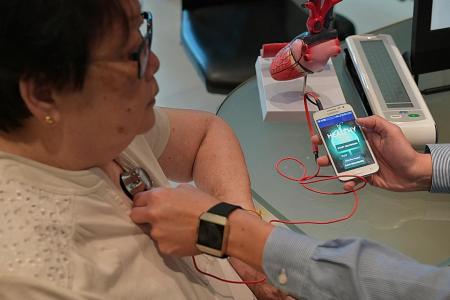New home-use device can help detect heart failure symptoms
Heart failure patient Madam Tan Hui Keng, 71, needs to go to a hospital emergency ward whenever she starts getting breathless. This happens around two times a year.
Soon, a home-use device may be able to tell patients like Madam Tan early whether their breathlessness is brought on by potential heart failure or if some other condition is at play.
This device checks for fluid accumulation in the lungs, which causes breathlessness and is one of the early symptoms of heart failure. It was developed by a team from Nanyang Technological University (NTU) and Tan Tock Seng Hospital (TTSH), which showcased the prototype yesterday.
Patients simply place a small sensor on their chest or back.
This picks up sounds from their lungs and sends the sound signals through a mobile app to a server in the cloud.
The server has an artificial intelligence algorithm that determines if the patient's lungs are clear or whether fluid is accumulating inside them.
The entire process takes 10 seconds, said Associate Professor Ser Wee from NTU's School of Electrical and Electronic Engineering.
The device can also help cut down on hospital admissions, said Associate Professor David Foo, who is the head of cardiology at TTSH.
The current methods to detect fluid accumulation in the lungs either involve doctors using a stethoscope to listen to the patient's breathing - which can be subjective - or chest X-rays or computed tomography scans, which are costly and time-consuming, he added.
Prof Foo estimates that the device stands to benefit 30 per cent to 40 per cent of the some 5,000 patients admitted to hospitals here for heart failure every year.
Ten years in the making, the device has been shown to have a more than 92 per cent accuracy rate in identifying patients who have fluid accumulation in their lungs, based on a study of 86 TTSH patients from 2012 to 2015.
The team has filed a patent for the device. It has also been approached by a major pharmaceutical company as well as multinational and local healthcare companies for possible collaborations.
Prof Ser said the device could cost patients between $100 and $200.
Get The New Paper on your phone with the free TNP app. Download from the Apple App Store or Google Play Store now


